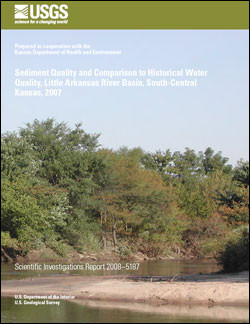
Product Details
- Product Number
- 242667
- Series
- SIR-2010-5191
- Scale
- NO SCALE
- Alternate ID
- SIR-2010-5191
- ISBN
- 978-1-4113-2973-7
- Authors
- KYLE E JURACEK
- Version Date
- 01/01/2010
- Regions
- KS
- Countries
- USA
- Media
- Paper
- Format
- Bound
Additional Details
- Description
- A combination of available bathymetric-survey information, bottom-sediment coring, and historical streamgage information was used to investigate sedimentation, sediment quality, and upstream channel stability for John Redmond Reservoir, east-central Kansas. Ongoing sedimentation is reducing the ability of the reservoir to serve several purposes including flood control, water supply, and recreation. The total estimated volume and mass of bottom sediment deposited between 1964 and 2009 in the conservation pool of the reservoir was 1.46 billion cubic feet and 55.8 billion pounds, respectively. The estimated sediment volume occupied about 41 percent of the conservation-pool, water-storage capacity of the reservoir. Water-storage capacity in the conservation pool has been lost to sedimentation at a rate of about 1 percent annually. Mean annual net sediment deposition since 1964 in the conservation pool of the reservoir was estimated to be 1.24 billion pounds per year. Mean annual net sediment yield from the reservoir basin was estimated to be 411,000 pounds per square mile per year Information from sediment cores shows that throughout the history of John Redmond Reservoir, total nitrogen concentrations in the deposited sediment generally were uniform indicating consistent nitrogen inputs to the reservoir. Total phosphorus concentrations in the deposited sediment were more variable than total nitrogen indicating the possibility of changing phosphorus inputs to the reservoir. As the principal limiting factor for primary production in most freshwater environments, phosphorus is of particular importance because increased inputs can contribute to accelerated reservoir eutrophication and the production of algal toxins and taste-and-odor compounds. The mean annual net loads of total nitrogen and total phosphorus deposited in the bottom sediment of the reservoir were estimated to be 2,350,000 pounds per year and 1,030 ,000 pounds per year, respectively. The estimated mean annual net yields of total nitrogen and total phosphorus from the reservoir basin were 779 pounds per square mile per year and 342 pounds per square mile per year, respectively. Trace element concentrations in the bottom sediment of John Redmond Reservoir generally were uniform over time. As is typical for eastern Kansas reservoirs, arsenic, chromium, and nickel concentrations typically exceeded the threshold-effects guidelines, which represent the concentrations above which toxic biological effects occasionally occur. Trace element concentrations did not exceed the probable-effects guidelines (available for eight trace elements), which represent the concentrations above which toxic biological effects usually or frequently occur. Organochlorine compounds either were not detected or were detected at concentrations that were less than the threshold-effects guidelines. Stream channel banks, compared to channel beds, likely are a more important source of sediment to John Redmond Reservoir from the upstream basin. Other sediment sources include surface-soil erosion in the basin and shoreline erosion in the reservoir.
- Survey Date
- 1964
- Print Date
- 2010
- Height In Inches
- 11.000
- Length In Inches
- 8.500
- Two Sided
- Yes
- Pieces
- 1
- Languages
- English
Related Items



